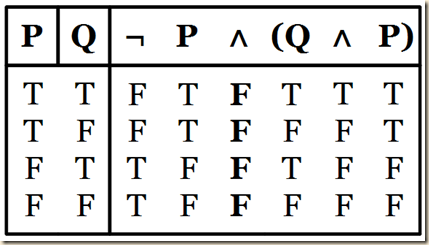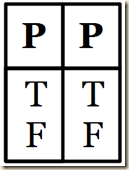by Corry Shores
[Search Blog Here. Index-tags are found on the bottom of the left column.]
[Central Entry Directory]
[Logic & Semantics, Entry Directory]
[David Agler, entry directory]
[Agler’s Symbolic Logic, entry directory]
[The following is summary. Boldface (except for metavariables) and bracketed commentary are my own. I highly recommend Agler’s excellent book. It is one of the best introductions to logic I have come across.]
Summary of
David W. Agler
Symbolic Logic: Syntax, Semantics, and Proof
Ch.3: Truth Tables
3.3 Truth Tables Analysis of Propositions
Brief Summary:
We can use a decision procedure to determine whether a singular proposition is a tautology, a contradiction, or a contingency. It is a tautology if it is true under all value assignments; it is a contradiction if it is false under all value assignments, and it is a contingency if it is either true or false, depending on what the value assignments are.
Summary
3.3 Truth Tables Analysis of Propositions
We will use decision procedures to determine whether or not propositions or arguments have certain logical properties.
Decision procedure: A decision procedure is a mechanical method that determines in a finite number of steps whether a proposition, set of propositions, or argument has a certain logical property.
(76)
Concerning propositions simply, we are interested in determining whether they have three certain properties:
1) are they always true (tautological)?
2) are they always false (contradictory)? or
3) are they neither always true nor always false (contingent)? (Agler 76)
We will use truth tables for conducting the decision procedures for “determining whether a proposition has one of these three properties; that is, it is a mechanical method that will give us a yes or no answer as to the question, Is ‘P’ contingent? Is ‘P∨¬P’ a tautology? and so on” (76).
3.3.1 Tautology
Consider this sentence:
John is tall or not tall.
It is always true, and thus it is a tautology (76). This is because it is true under every possible valuation for the atomic letters composing it.
Tautology: A proposition ‘P’ is a tautology if and only if ‘P’ is true under every valuation. A truth table for a tautology will have all ‘Ts’ under its main operator (or in the case of no operators, under the propositional letter).
(77)
We consider the truth table for P→(Q→P).
Since all assignments evaluate the proposition as true, it is a tautology.
But as we can see, P∧(Q→P) is not a tautology:
3.3.2 Contradiction
Consider the sentences, “Mary is the murderer, and she isn’t,” and “A is not A” (77). These propositions must always be false, because no matter what value you assign to the atomic propositions, the output value will in each case be false.
Contradiction: A proposition ‘P’ is a contradiction if and only if ‘P’ is false under every valuation. A truth table for a contradiction will have all ‘Fs’ under its main operator (or in the case of no operators, under the propositional letter).
(78)
So consider the truth table evaluation for ¬P∧(Q∧P):
But we recall again P∧(Q→P), and we see it also is not a contradiction, because in two cases of truth assignments, it is true.
3.3.3 Contingency
Consider the sentences, “Mary is the murderer,” and “Politicians are untrustworthy”. These can be either true or false, depending on the truth assignments. Thus they are contingencies.
Contingency: A proposition ‘P’ is a contingency if and only if ‘P’ is neither always false under every valuation nor always true under every valuation. A truth table for a contingency will have at least one ‘T’ and at least one ‘F’ under its main operator (or in the case of no operators, under the propositional letter).
(79)
A simple example is the truth table for just P.
The evaluated P has both one T and one F under it, and thus it is a contingency. For, “it is neither always true nor always false” (79).
Another example of a contingency is P→Q.
We again recall the truth table for P∧(Q→P):
We determined already that it is neither a tautology nor a contradiction. That automatically makes it a contingency, and we can see that from the fact that it is either true or false, depending on the assignments (79-80).
Agler, David. Symbolic Logic: Syntax, Semantics, and Proof. New York: Rowman & Littlefield, 2013.
.

















































No comments:
Post a Comment